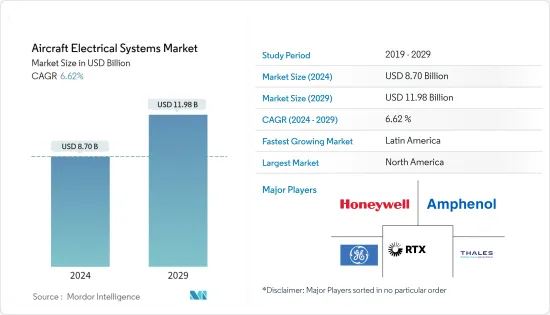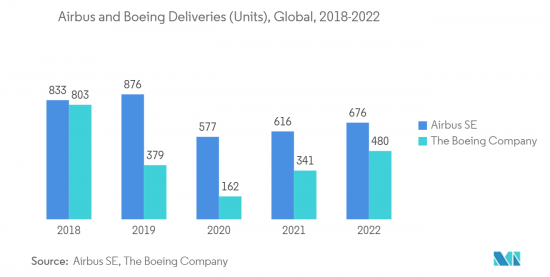PUBLISHER: Mordor Intelligence | PRODUCT CODE: 1405358

PUBLISHER: Mordor Intelligence | PRODUCT CODE: 1405358
Aircraft Electrical Systems - Market Share Analysis, Industry Trends & Statistics, Growth Forecasts 2024 - 2029

The Aircraft Electrical Systems Market size is estimated at USD 8.70 billion in 2024, and is expected to reach USD 11.98 billion by 2029, growing at a CAGR of 6.62% during the forecast period (2024-2029).
Key Highlights
- The aircraft electrical systems market witnessed unparalleled challenges due to the COVID-19 pandemic. It also had a significant impact on the economy, leading several aerospace companies to pause funding for innovative projects.
- Disruptions in supply chains, reduced demand for new aircraft, and postponed aircraft modernization programs hindered market growth during the pandemic. However, the market showcased a strong recovery post-COVID, driven by increasing commercial aircraft orders and a rising number of aircraft modernization programs.
- The aircraft's electrical system is a critical part of its overall design and functionality. It plays a vital role in powering essential systems, avionics, and onboard equipment. An aircraft electrical system consists of four essential sub-systems, namely power generation, distribution, conversion, and storage. The emergence of the more-electric aircraft concept has revolutionized conventional aircraft electrical power architecture.
- The more-electrified architecture offers improved fuel efficiency, reduced maintenance costs, improved reliability using modern power electronics, and fewer hydraulic and pneumatic components in the engine installation. In addition, short-range electric aircraft are expected to become viable during the upcoming period.
- Moreover, the market is driven by various factors such as improvements in commercial aviation networks, the increasing number of air passengers leading to the growing demand for more aircraft, the growing tourism sector, and innovations in fuel-efficient aircraft. On the other hand, limitations in aircraft battery technologies are expected to restrain global electrical system market growth.
Aircraft Electrical Systems Market Trends
Commercial Aviation Segment Will Showcase Remarkable Growth During the Forecast Period
The commercial aviation segment holds the highest shares in the market and continues its domination during the forecast period. The growth is attributed to the increasing commercial aircraft deliveries and rising aircraft modernization programs. Passenger traffic is gradually recovering from the impact of the pandemic and is expected to surpass the pre-pandemic levels by the end of 2023. The recovery is attributed to growing domestic travel across the globe. With the growing domestic passengers, the demand for commercial aircraft is expected to witness robust growth in the coming years, with a subsequent demand impact on the aircraft's electrical systems. During 2022, Airbus and Boeing delivered 663 and 480 aircraft, respectively, signifying a significant growth over the 2021 figures, marred by widespread bottlenecks and production delays due to supply chain disruptions.
Several new aircraft orders are expected to be placed during the forecast period, driving the demand for integrated systems and subsystems, including electrical systems. Moreover, the rise of electric propulsion technology is being explored in the commercial aviation sector. Electrically powered aircraft contain the potential to reduce greenhouse gas emissions and noise pollution compared to traditional jet engines. Electric motors, batteries, and advanced power management systems are being developed to support electric propulsion in commercial aircraft.
Currently, hybrid-electric systems, combining traditional combustion engines with electric motors, are being explored as an intermediate step toward fully electric aircraft. For instance, in March 2023, Evfly gave a contract to 205 Prosperity I and Prosperity Cargo aircraft to AutoFlight. In February 2023, AutoFlight tested its Gen4 eVTOL electric aircraft with a record-breaking 250 km flight on a single charge on a circuit. Gen4 aircraft is equipped with the latest avionics and also uses third-party avionics to record and verify the distance covered on the independent system 'Foreflight.'

North America to Dominate Market Share in the Aircraft Electrical Systems Market
North America is projected to continue its dominance in terms of market share due to the presence of a well-flourished aviation industry, the highest number of commercial and military aircraft fleets in the US, and rising aircraft modernization programs from airlines, driving the growth of the market. Furthermore, the United States includes the highest number of airports in the world. There are around 19,919 total airports within the US, including international airports, private airports, and regional public airports. Thus, growing commercial and military aircraft fleets and rising expenditure on aircraft modernization programs lead to increasing demand for advanced electrical systems, hence driving the market growth. For instance, in January 2023, the US Air Force Life Cycle Management Center signed an eight-year contract worth USD 900 million with five companies to provide wiring harnesses and kit assemblies for the Air Force F-16 combat jet fleet. In March 2022, Boeing and Safran signed contracts for electrical wiring. The contract covers the Boeing P8, B787 Dreamliner, B767-2C, B767 Freighter, B737 MAX, B777, and B777-X aircraft. On this note, in 2021, Safran produced more than 225,000 electrical wire assemblies for B767 Freighter and B737, B777, and B787 aircraft, signifying a high-demand scenario with the evolution and adoption of more electric architecture in the aviation sector.
Aircraft Electrical Systems Industry Overview
The aircraft electrical systems market is fragmented, and it is witnessing the emergence of several regional Tier 1 and Tier 2 market players that provide full lifecycle support, ranging from conceptual design and testing to regulatory compliance certification. Hence, leading market players, such as General Electric Company, THALES, Honeywell International Inc., RTX Corporation, and Amphenol Corporation, combine value engineering techniques and design automation expertise to design cost-effective next-generation aircraft electrical systems. Since the design of each commercial aircraft family is moderately different from the other, an integrated electric system should be modular to allow for provisions for altering the connection layout to ensure compatibility. For instance, in June 2021, Rolls-Royce plc initiated ground testing of a hybrid-electric power and propulsion system designed for use in regional aircraft. The company initiated testing of the AE2100 engine element, specialist controls, and thermal management system, supported by a system integration generator at Testbed 108 in Bristol, United Kingdom, as part of its 2.5 MW Power Generation System 1 (PGS1) demonstrator program. Such developments render a positive outlook for the commercial aviation segment of the market in focus during the forecast period.
In military aviation, the electrical architecture of an aircraft may be totally different from another, and it is highly dependent on the mission profile. For instance, an ISR aircraft would include provisions for integrating additional equipment, while a fighter aircraft would focus on integrating more weapon systems. It presents a design challenge for electrical system manufacturers and may expose the market players to financial risks owing to the high R&D expenditure divested toward designing advanced electrical systems. For instance, in August 2023, Bell awarded a contract to Astronics Corporation for the system integration services, power system design and development, and preliminary flight hardware deliveries for Bell's V-280 Valor aircraft for the US Future Long Range Assault Aircraft (FLRAA) program. Astronics Corporation's Astronics CorePower® solution supports the US Army Modular Open Systems Architecture (MOSA) initiatives. It delivers clean, intelligent, and efficient power that improves aircraft performance and reduces overall system weight.
Additional Benefits:
- The market estimate (ME) sheet in Excel format
- 3 months of analyst support
TABLE OF CONTENTS
1 INTRODUCTION
- 1.1 Study Assumptions
- 1.2 Scope of the Study
2 RESEARCH METHODOLOGY
3 EXECUTIVE SUMMARY
4 MARKET DYNAMICS
- 4.1 Market Overview
- 4.2 Market Drivers
- 4.3 Market Restraints
- 4.4 Industry Attractiveness - Porter's Five Forces Analysis
- 4.4.1 Bargaining Power of Suppliers
- 4.4.2 Bargaining Power of Buyers/Consumers
- 4.4.3 Threat of New Entrants
- 4.4.4 Threat of Substitute Products
- 4.4.5 Intensity of Competitive Rivalry
5 MARKET SEGMENTATION
- 5.1 System
- 5.1.1 Power Generation
- 5.1.2 Power Distribution
- 5.1.3 Power Conversion
- 5.1.4 Energy Storage
- 5.2 Platform
- 5.2.1 Commercial Aviation
- 5.2.2 Military Aviation
- 5.2.3 General Aviation
- 5.3 Geography
- 5.3.1 North America
- 5.3.1.1 United States
- 5.3.1.2 Canada
- 5.3.2 Europe
- 5.3.2.1 United Kingdom
- 5.3.2.2 France
- 5.3.2.3 Germany
- 5.3.2.4 Spain
- 5.3.2.5 Rest of Europe
- 5.3.3 Asia-Pacific
- 5.3.3.1 China
- 5.3.3.2 India
- 5.3.3.3 Japan
- 5.3.3.4 South Korea
- 5.3.3.5 Rest of Asia-Pacific
- 5.3.4 Latin America
- 5.3.4.1 Brazil
- 5.3.4.2 Mexico
- 5.3.4.3 Argentina
- 5.3.4.4 Rest of Latin America
- 5.3.5 Middle East and Africa
- 5.3.5.1 Saudi Arabia
- 5.3.5.2 United Arab Emirates
- 5.3.5.3 South Africa
- 5.3.5.4 Rest of Middle East and Africa
- 5.3.1 North America
6 COMPETITIVE LANDSCAPE
- 6.1 Vendor Market Share
- 6.2 Company Profiles
- 6.2.1 RTX Corporation
- 6.2.2 Amphenol Corporation
- 6.2.3 Honeywell International Inc.
- 6.2.4 THALES
- 6.2.5 General Electric Company
- 6.2.6 Acme Aerospace Inc. & Avionic Instruments LLC
- 6.2.7 Astronics Corporation
- 6.2.8 Crane Aerospace & Electronics
- 6.2.9 AMETEK, Inc.
- 6.2.10 Hartzell Engine Technologies LLC
- 6.2.11 Meggitt PLC
- 6.2.12 Nabtesco Corporation
- 6.2.13 PBS AEROSPACE Inc.
- 6.2.14 Safran
7 MARKET OPPORTUNITIES AND FUTURE TRENDS




